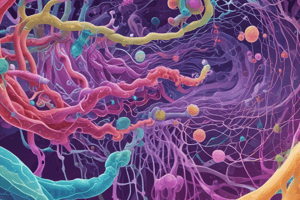Podcast
Questions and Answers
What is the main function of the cell wall in bacteria?
What is the main function of the cell wall in bacteria?
- To aid in the synthesis of proteins
- To provide rigidity, tensile strength, and structural support (correct)
- To provide nutrition to the cell
- To facilitate the movement of bacteria
What are inclusions in a bacterial cell?
What are inclusions in a bacterial cell?
- Living components of the cell bounded by membranes
- Flagella that aid in cellular locomotion
- Ribosomes responsible for protein production
- Nonliving components of the cell that do not possess metabolic activity and are not bounded by membranes (correct)
What is the function of fimbriae in bacteria?
What is the function of fimbriae in bacteria?
- To synthesize proteins
- To facilitate the attachment of a bacterium to a surface (correct)
- To provide nutrition to the cell
- To facilitate the movement of bacteria
What is the function of pili in bacteria?
What is the function of pili in bacteria?
What is the main component of the bacterial cell wall?
What is the main component of the bacterial cell wall?
What is the characteristic of gram-positive cell walls?
What is the characteristic of gram-positive cell walls?
What is the function of endospores in bacteria?
What is the function of endospores in bacteria?
What is the function of ribosomes in bacteria?
What is the function of ribosomes in bacteria?
What are the common inclusions found in bacterial cells?
What are the common inclusions found in bacterial cells?
What can be easily gained or lost by a bacterium and can be transferred between bacteria?
What can be easily gained or lost by a bacterium and can be transferred between bacteria?
Flashcards are hidden until you start studying
Study Notes
Bacterial Cell Walls
- Gram-negative cell walls are thin, containing a thin peptidoglycan layer (5-10%) adjacent to the cytoplasmic membrane.
- Gram-positive cell walls are thick, with a peptidoglycan layer forming almost 95% of the cell.
Flagella
- Flagella are extracellular bacterial cell structures responsible for bacterial motility.
- The arrangement of flagella about the bacterial cell is unique to the species observed.
- Common forms of flagella include:
- Monotrichous
- Lophotrichous
- Amphitrichous
- Peritrichous
Bacterial Reproduction
- Binary fission
- Sexual reproduction
Bacterial Growth
- Lag phase: a period of slow growth when cells adapt to the high-nutrient environment and prepare for fast growth.
- Log phase: rapid exponential growth.
- Stationary phase: caused by depleted nutrients, cells reduce metabolic activity and consume non-essential cellular proteins.
- Death phase: bacteria run out of nutrients and die.
Environments Inhabited by Bacteria
- Aerobes (aerobic bacteria): grow only in the presence of oxygen.
- Anaerobes (anaerobic bacteria): grow only in the absence of oxygen.
- Facultative anaerobes (facultative anaerobic bacteria): grow in environments with or without oxygen.
Bacteria and Disease
- Some bacteria are pathogenic (disease-causing) to plants and animals.
- Bacteria can cause diseases through consumption of contaminated food and water, inhalation, and sexually transmission.
Morphology
- Bacteria display a wide diversity of shapes and sizes.
- Size of bacteria: 0.2 – 1.5 µm in diameter, 3 – 5 µm in length.
- Shapes of bacteria:
- Cocci: spherical or oval cells
- Bacilli: rod-shaped cells
- Vibrio: comma-shaped curved rods
- Spirilla: rigid spiral forms
- Spirochetes: flexuous spiral forms
- Actinomycetes: branching filamentous bacteria
- Mycoplasmas: bacteria without a cell wall, occurring as round or oval bodies and as interlacing filaments
Bacterial Structure
- Bacteria contain a well-developed cell structure responsible for many of their unique biological functions.
- Components of bacterial cells:
- Cell wall: outer covering of the cell that protects the bacterial cell and gives it shape.
- Cell membrane: surrounds the cell's cytoplasm and regulates the flow of substances in and out of the cell.
- Cytoplasm: a gel-like substance composed mainly of water that also contains enzymes, salts, cell components, and various organic molecules.
- Nucleoid region: area of the cytoplasm that contains the single bacterial DNA molecule.
- Ribosomes: cell structures responsible for protein production.
- Plasmids: small independent pieces of DNA that can be easily gained or lost by a bacterium and can be transferred between bacteria.
- Flagella: long, whip-like protrusions that aid in cellular locomotion.
- Endospores: bacterial survival structures that are highly resistant to many different types of chemical and environmental stresses.
- Fimbriae: protein tubes that extend out from the outer membrane, facilitating the attachment of a bacterium to a surface.
- Pili: similar in structure to fimbriae but are much longer and present on the bacterial cell in low numbers, involved in the process of bacterial conjugation.
Studying That Suits You
Use AI to generate personalized quizzes and flashcards to suit your learning preferences.




